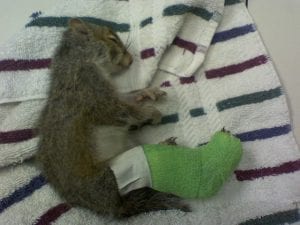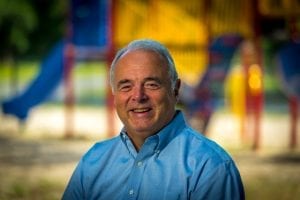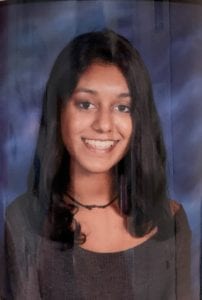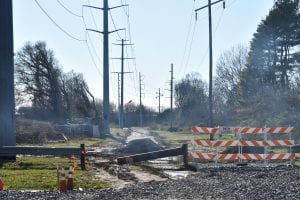YEAR OF THE DAFFODIL
Susan Wilk of Sound Beach sent in these gorgeous photos from her garden to share with our readers. She writes, ‘It’s a steller year for daffodils. Enjoy!’
CLOUDY DAY REFLECTIONS
Elisa Hendrey of Sound Beach snapped this surreal photo at Mt. Sinai Harbor on March 19 using her iPhone 6.
Send your Photo of the Week to [email protected]
By Melissa Arnold
As most businesses come to a standstill to aid in social distancing, many people are looking for ways to help their neighbors and community. While there’s plenty to do for one another, local wildlife organizations have their own plea: Don’t forget the animals.
It’s a tough time for places like the Save the Animals Rescue (STAR) Foundation in Middle Island, a non-profit which rescues and rehabilitates a wide variety of injured wildlife. They also provide a place of sanctuary for those animals not well enough to return to their natural habitats.

“We rescue those unusual pets that people have abandoned, birds and reptiles, guinea pigs, rabbits, and we’ve been doing this for 25 years,” said STAR Foundation co-director Lori Ketcham. “We are 100 percent reliant on volunteers, and have no paid staff or municipal support. [Normally] about 30 hands-on volunteers assist with rescues, provide animal care, clean cages, help with transport and do whatever else we need help with.”
The STAR Foundation has a long-standing relationship with the Animal Emergency Service clinic in Selden. Temporary limits on staffing and social distancing measures have added additional pressure to the clinic, and for now, STAR is no longer able to send animals to them for immediate care.
“They’re short on equipment and supplies, and what can they do? We [in the animal care field] need gloves and masks just like every other profession, and when those things are gone, they’re gone,” Ketcham said. “And while we’d happily welcome vets who are willing to provide care, not every vet is certified to work with wild animals, so we can’t turn to just anyone.”
The warmest months of the year are also the busiest times for animal rescue organizations, between the arrival of new baby animals and those that sustain injuries while out and about. STAR cares for about 150 animals at a time — currently they’re bottle-feeding baby squirrels and rabbits, caring for woodchucks and all kinds of birds, from quail to great horned owls, and small exotic pets with nowhere to go thanks to suspended adoptions.
While the foundation is keeping a skeleton crew of two to three people on-site, sanitizing regularly and staying separated as much as possible, each new person that enters the building resets that process and introduces new risks, Ketcham explained.
At Sweetbriar Nature Center in Smithtown, they have the same concerns.
“It’s certainly a big challenge for us — since we’ve been closed to the public, we have only one or two people coming in to work,” said Sweetbriar’s education director Eric Young. “Volunteers have taken some of the animals home for care, but that’s only temporary.”

The center is home to countless animals of all kinds, from bustling ant colonies and hissing cockroaches to box turtles and groundhogs, the occasional goats and foxes, to name a few. Young estimates there are around 50 different kinds of animals on site. At the moment, its on-site Wildlife Rehabilitation Center is caring for several owls and rabbits, a hawk that suffered a gunshot wound, gulls and Canada geese, among others.
As education director, Young said he’s feeling the loss of the many students who visit the center at this time of year. Sweetbriar interacts with thousands of students annually, including in-school presentations and class field trips.
Now, with schools closed and students adjusting to digital learning in varied forms, Young is trying to find creative ways to bring the animals online.
“We’re thinking about sharing our animal presentations on YouTube, and I’m in the process of putting together resources to share with teachers,” he said.
At this point, Director of Wildlife Rehabilitation Janine Bendicksen is simply hoping for a quick end to the pandemic so that they can ensure the wellbeing of the staff.
“The Town of Smithtown covers our utilities and major repairs, but we still depend on financial support to pay the salaries of our staff, care for the animals and purchase formula, medicine and food,” Bendicksen said. “Our greatest need right now is to continue to support our staff.”
Ketcham echoed the need for continued donations in these difficult times.
“We plan our fundraisers well in advance, and without doing five or six fundraisers a year, we’re not going to make it,” she said. “We don’t know what events we will be able to hold. Everything is up in the air right now. It costs about $8,000 a month to keep the center going, and donations have slowed to a trickle. We have utility bills and insurances, cleaning, food and medical supply bills, no matter what else is going on. Without programs or fundraisers, it will become critical in no time.”
Both the STAR Foundation and Sweetbriar Nature Center are encouraging those who wish to support them with donations to send money only at this time — please protect the staff and do not bring supplies to their physical locations.
To donate to the Save the Animals Rescue (STAR) Foundation, visit www.savetheanimalsrescue.org. Call 631-736-8207 for urgent assistance with wildlife.
To donate to Sweetbriar Nature Center, visit www.sweetbriarnc.org. For those who find an injured wild animal, call 631-979-6344 and leave a message.” All our phone calls go directly to an answering machine that we check each day, we will call them back and give advice. We will accept wildlife if possible,” said Bendicksen.
You can also visit the Department of Environmental Conservation website at www.dec.ny.gov and search for “wildlife rehabilitator near me” to connect with other rescue organizations in your area.
Reviewed by Melissa Arnold

Every year, tens of thousands of people from around the world flee their homes. They have any number of motivations, among them political turmoil, threat of violence, discrimination and climate change, to name a few.
Retired police officer Bill Kiley has deep compassion for asylum seekers of all kinds, and recently felt a strong desire to help them in some way. Kiley, 71, of East Northport, hopes that educating children about the plight of refugees can bring about a more supportive, empathetic culture in the next generation.
His new book, “Hope and Freckles: Fleeing to a New Forest” tells the story of a white-tailed deer named Hope and her spotted fawn, Freckles, as they attempt to escape the growing number of hunters in their forest and go in search of a place where they will be safe. The sharply written story and whimsical, beautifully-illustrated characters will stir the hearts of children and adults alike.
What was your childhood like?
I was raised in Brooklyn, lived in Queens after I got married, and came to this area when I started working for the Suffolk County Police Department years ago.
Were you creative from an early age?
I wasn’t creative at all. I’m one of nine children, and we lived in an apartment with one bathroom, so you can imagine what that was like! We played a lot of sports with our friends, and I started working during the summers when I was 11 to help contribute to the family.
What did you end up doing for a career?
After high school, I spent a couple of years working at the FBI as a clerk while I went to college at what is now John Jay College at night. My initial plan was to become an agent. Simultaneously, when I was 17 I joined the Army National Guard. I went away for six months of training right after my 18th birthday, and continued to go for additional training at other points which meant some breaks from school. I ultimately began working for the Suffolk County Police Department in 1972.
You must have met a lot of people from diverse backgrounds, then.
Of course. That was part of my motivation for writing this book. I wanted to shine a light on the struggles of refugees and asylum seekers all over the world. After 30 years in law enforcement and serving as an Army reservist, I recognize that this crisis threatens free democracy if it’s not dealt with. If we don’t step up, then our children and grandchildren will be left to deal with the global implications of people being pushed out of their countries and living in tent cities. Something needs to change.
When did you first start writing?
In retirement, I’ve had the opportunity to do a lot of babysitting for my granddaughters. We’re a few blocks away from a local library, and so when the kids were with me we’d sometimes go down to the library and head to the children’s section. I began reading to them, and then as they grew I’d read along with them. At that point I began to see the incredible power that children’s books have on young minds. All the while, I’d been looking for a way to help with the refugee crisis, and I began to think that maybe I could help young children understand what’s happening and have some positive influence on the future. I never had any ambitions to become an author.
How did you learn about publishing and sharpen your writing skills?
I read a lot with my grandkids. But in the spring of 2019, I found out about an annual convention in New York City called Book Expo at the Javits Center. I spent three days there. For me, it was a three-day immersive educational experience. I had the opportunity to meet lots of people from every aspect of the writing and publishing world, including some very generous folks who were authors of children’s books. They spent a lot of time sharing their experiences and advice with me, and then I went home and continued to read and learn as much as I could.

How did your family react when you told them you wanted to write a book?
Well, my wife, Kathy, and I were in school together since the first grade. We go back that far. And no one in my life has been as supportive of their spouse in life as my wife has been for me. In everything I’ve ever tried, she’s been there, and this was just another one of those things.
My granddaughters have been involved in this project from the get-go. They gave great feedback and I’ve had the chance to share the book with their classmates, too.
Is there a reason why you chose to make the characters animals instead of people?
I thought that since this is such a sensitive subject to explain to children, it would be less upsetting to use animals. The national animal of Honduras is the white-tailed deer, and as many refugees come from that area, I thought it was an appropriate choice.
How did you go about getting published?
I met a number of people from traditional publishing companies, independent publishers and hybrids. One of them was a man who recommended his publisher, Mascot Books in Herndon, Virginia. I submitted my manuscript and was happy to learn that they were going to accept it.
What about the illustrations?
I contacted freelancers all over the world, and Mary Manning’s work is so unique and beautiful. I’m so happy with what she’s done for the book. Once the manuscript was finalized, Mary broke the manuscript into logical scene breaks, then made pencil sketches for me to approve. She took it from there. To see the final copy was like holding my children and grandchildren for the first time. There was a feeling of, “Oh my gosh, we just gave birth to a book!”
This book also includes vocabulary words and questions for discussion. Why did you choose to add those?
As I was researching and reading different children’s books, I found a couple that had some variation of continuing discussion. My hope is that this book isn’t just read by 7 to 10 year olds, but that their families will read along with them and share in the experience and conversations that can happen afterward. A parent or other adult might feel ill-equipped to start a discussion on their own, so I thought having some starter questions might be helpful.
What do you want children to take away from reading this book?
The response from the classes I’ve read to so far has been wonderful. Kids have shared that they never thought about what it would be like to leave your home because of danger; to not have a school to go to or books to read; that they are grateful for what they have. That has been like gold to me.
It’s easy for people in our country to automatically look at the U.S,-Mexican border as the only place of crisis. But this is a global issue. The U.N. estimates that around 26 million people around the world have had to flee their homes, often to places where they are unwanted. Half of those refugees are children. I hope kids who read this book come to understand that there are people their age that are in that situation, and empathize with the plight of refugees all over the world.
What’s next for you?
My hope is to do a series of four books, all with these same characters, following their journey as it continues on. I’ll be reading from the book at Barnes and Noble stores around Long Island and New York City in the future. I am also available to speak about the book at schools, religious congregations and events.

“Hope and Freckles: Fleeing to a New Forest” is available online at www.mascotbooks.com, www.Amazon.com or www.BN.com. To learn more about Bill Kiley, this book and future projects, visit www.hopeandfreckles.com.
‘Life throws challenges and every challenge comes with rainbows and lights to conquer it.’
― Amit Ray
WELCOME SPRING!
Photographer Mimi Hodges of Sound Beach ventured out in her backyard on March 15 to capture images of these beautiful flowers, “reasons for joy,” and which she now shares with you as we welcome spring to our neck of the woods.

By Sapphire Perera
I haven’t been to school in 13 days and I don’t know when I’m going back. Many of the shelves in the grocery stores are empty, toilet paper is sold out and everyone is self-quarantining. This panic and fear are due to the outbreak of the most current pandemic — the coronavirus, also known as COVID-19. This new strain of coronavirus originated in China and has spread globally. While it seems improbable that there’s a connection between pandemics and climate change, past pandemics prove otherwise. This connection shows us that for every action, there is a reaction.
Interview with Dr. Lisa M. Chirch
Dr. Lisa M. Chirch is a associate professor of medecine at the University of Connecticut who specializes in infectionous diseases.
SP: Sapphire Perera; LC: Lisa Chirch
SP: Due to habitat loss, there is evidence of vector transference between wild animals and livestock. Do you think this will eventually involve household pets, which may be more susceptible to loss of native immunity?
LC: Good question, and very important to those of us with household pets we adore as part of the family. To date, it is unclear whether viral infections such as COVID-19 can infect dogs and cats, or whether they would become ill if infected. It really depends on the specific organism and how they infect, which tissues are targets, which receptors are used for cell entry, etc. Certainly, the potential for domestic animals to be affected is present, and we should probably be taking similar precautions with our beloved pets as with our family members whom we want to protect.
SP: Extreme changes in global weather patterns are one factor of climate change. With increases in climate change and warmer weather, do you feel that future pandemics will originate in places such as North America and Western Europe instead of Asia and Africa, as they did with the 1918 Spanish flu?
LC: Throughout history, pandemics have originated from sites all over the world. Pandemics originate when humans are exposed to “novel” organisms we have never seen before, exposing populations without immunity. Over time these have frequently been related to the animal/human interface in some way, with organisms “jumping” from one species to another, and in the worst-case scenario, becoming efficient at human-to-human transmission. So, to the extent that climate change drives animals and humans further together, it drives the possibility of further epidemics. Importantly, climate change has more immediate and tangible effects on infectious diseases in humans that have been recently notable, such as the appearance of certain mosquito-borne arboviruses in the southern U.S. (dengue, chikungunya, Zika), and tick-borne illnesses migrating northward as well, with the associated northward movement of the tick species that carry them.

Climate change has made our winters shorter and the weather unseasonably warm. This global increase in temperature is just one of the causes of climate change, and directly affects vectors i.e., disease-carrying organisms such as mosquitoes, ticks, fleas and flies. These vectors spread diseases such as malaria, dengue fever, West Nile virus, and yellow fever which are some of the worst pandemics. The global increase in temperature is driving these vectors further from the equator and into the northern hemisphere. For instance, the United States has seen increased cases of dengue and malaria in Florida, California and Texas. Europe and the U.S. may soon be subjected to the same epidemics that plague people in equatorial climates. In contrast, other regions that usually struggle through the worst of the pandemics and epidemics will see a decrease in the number of outbreaks.
The increase in temperature, rainfall and humidity also creates more breeding grounds for vectors, leading to the easier spread of diseases. This was exemplified by India’s monsoon season from 1994 to 1996. The excessive monsoon rainfall and high humidity in the Punjab region of India led to an increase in malaria epidemics in places such as Rajasthan, Manipur, Nagaland and Haryana. Recent studies have shown that El Niño has actually increased the malaria epidemic risk in India by about fivefold. El Niño scientists have discovered increases in incidences of cholera, Zika, chikungunya, and hantavirus with El Niño occurrences.
Deforestation is another cause of climate change that brings vectors closer to urban communities. Sonia Shah, the author of the book “Pandemic,” says in her article in The Nation, “When deforestation threatens the survival of wild species, there are more opportunities for animal microbes to adapt to human bodies.” One example from the many pandemics that we’ve had in the past is the Ebola outbreak. In places such as Central and West Africa, there have been serious deforestation and habitat losses for bats, which are vectors for Ebola. These bats started inhabiting places closer to urban populations which, in turn, increased the likelihood of Ebola outbreaks. Studies in 12 countries have actually shown that it is twice as common to have vector mosquitoes in deforested areas than in intact forests.
Apart from bringing vectors close to human communities, climate change is introducing prehistoric diseases to mankind. In 2016, the Russian city of Yakutsk saw the outbreak of anthrax during a heat wave in Siberia. The thawing permafrost soil there released long-dormant bacteria and viruses that had been trapped in the ice for centuries. One 12-year-old boy died and at least 20 people were hospitalized from infection. Scientists speculate that more diseases lie beneath the ice and with the rising global temperature, we may see the reemergence of diseases such as smallpox, the bubonic plague and the 1918 Spanish flu.
Since January, there has been a significant universal decrease in social and economic activity. The results from this are astounding. First of all, since there has been slower economic activity, there has been a drop in carbon dioxide emissions. In Hubei province in Central China, there has been a drop in air pollution as the cloud of nitrogen dioxide evaporated in February. Italy saw similar results in its environment pertaining to nitrogen dioxide levels. Additionally, the once-murky canal water in Venice is now so clear that you can see the fish below. In countries all over the world, we are seeing changes like this. Unfortunately, it’s taking a pandemic brought about by climate change to reduce climate change.
Sapphire Perera is a junior at Port Jefferson high school. The “Turtle Island,” as the name for this ongoing column refers to the Native American mythology about North America existing on the back of a great turtle that bears every living being on its spine.
PINK TWILIGHT
Dawn Olenick of Baiting Hollow was driving along Sound Avenue in Riverhead on the night of Feb. 6 when she captured this stunning sunset.
Send your Photo of the Week to [email protected]

The North Shore Rail Trail, formerly known as the Rails to Trails Recreational Path, is an approximately 10-mile recreational path and is currently under construction on the former Long Island Rail Road right of way, owned by the Long Island Power Authority. The trail runs from Crystal Brook Hollow Road in Mount Sinai to Wading River Manor Road in Wading River and parallels Route 25A.

In a release, Suffolk County Leg. Sarah Anker’s (D-Mount Sinai) office said that Suffolk County Department of Public Works and DF Stone Contracting have removed the topsoil from west to east along the trail path and will continue to grade the area and lay down the subbase within the upcoming months. DPW anticipates that it will begin laying down asphalt from west to east after April 15, weather permitting. Shrubbery has been removed to clear a handicap-accessible path at the Town of Brookhaven Rose Caracappa Senior Center in Mount Sinai. The trail is estimated to be completed in the fall of 2021.
The project was first suggested over 50 years ago by local civic members and was reintroduced in 2001 by advocates of bicycle organizations, the Setauket-Port Jefferson Station Greenway Trail and some community residents. The path is being funded by federal and state grants totaling close to $10 million, with a $500,000 match from Suffolk County. Suffolk County entered into a licensing agreement with LIPA to utilize the right of way for the trail. The engineering group NV5 was chosen by DPW to plan and design the trail.
In 2019, DPW approved DF Stone Contracting to construct the trail, reducing the cost of construction by approximately $2 million through the request-for-proposal process. The release said the county will work with the Town of Brookhaven Highway Department and New York State Department of Transportation for trail signage and lighting installation at road intersections. Maintenance of the trail will involve a partnership with not-for-profit organizations and Suffolk County Department of Parks. Suffolk County police and SCDP will provide law enforcement oversight for the trail.
People looking for more information can contact Anker’s office at 631-854-1600.

With the weather warming, and with more people available to take walks while home from work and school (maintaining social distancing, of course), one local Boy Scout’s Eagle Scout Service Project has made a lasting impact.
Port Jefferson resident Cole Swensen, a member of Miller Place Boy Scout Troop 204, installed a bench, along with concrete pads on the Setauket-Port Jefferson Station Greenway Trail earlier this month.
“I’m happy with the finished product,” Swensen said.
Swensen, a senior at Earl L. Vandermeulen High School in Port Jefferson, said he and his dad use the trail often for running and biking and saw there was a need for a new bench, made from wood composite, at the top of the hill just after the westernmost trail entrance in Setauket. The young man also installed three concrete pads on the trail, one at his new bench and two more at existing benches.
“These pads not only clean up the look of the benches and trail, but they also prevent the area in front of the benches from getting muddy,” Swensen said. “It also is a place for strollers to easily get off the main trail.”
Charlie McAteer, the chair of the Friends of the Greenway, said Troop 204 has been a huge boon to the trail, having done five projects with the Greenway, with one more still in the planning phase. This new project comes just as the Greenway is getting increased usage thanks to more people looking to spend time outdoors while maintaining a distance from others.
“This is a remarkable commitment to the Setauket to Port Jeff Station Greenway Trail,” McAteer said. “The community will be enjoying these for decades.”
The high school senior said he had been working on the project since before last summer but had to put it on pause after a severe bike accident led to a concussion. He conducted his fundraising last month, just as things with the coronavirus crisis were starting to close in. Still, he managed to raise about $1,000 toward the project. The build was over a three-day period with the bulk of the work centered on installing the new bench and making sure the concrete pads were leveled against the slope of the hill.
Swensen said he is still waiting on the finalized paperwork for his Eagle Scout application, since all offices are closed everything now has to be mailed.
After graduating high school, Swensen expects to attend SUNY Maritime to study naval architecture, involved in designing the hulls of boats and ships.
Swensen’s father, Eric, said his son has been interested in boats and sailing since he was young.
LUNCH TIME
Gerard Romano of Port Jefferson Station spotted this early migrant egret feeding in the shallows of Setauket Harbor on March 11
Send your Photo of the Week to [email protected]
